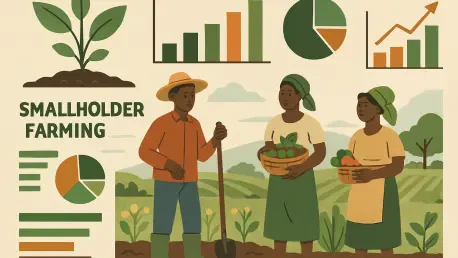In the vast landscapes of Southern Africa, particularly within the Chinyanja Triangle that stretches across Malawi, Mozambique, and Zambia, smallholder farmers grapple with an array of challenges, from unpredictable climate shifts to persistent pest threats and volatile market conditions. Amid these struggles, a transformative movement is gaining momentum, driven by the power of high-quality data, strategic alliances, and cutting-edge digital tools. This shift is not merely a trend but a fundamental change in how agriculture supports livelihoods in the region. Smallholder farmers, often working with limited means, are discovering innovative ways to enhance productivity and build resilience against the odds. The integration of crops like soybean into traditional maize-based systems exemplifies this progress, focusing on smarter, sustainable growth rather than just increased output. This exploration delves into the critical components fueling this agricultural revolution, shedding light on the mechanisms that are reshaping farming practices and uplifting entire communities through informed, collaborative efforts.
Harnessing the Strength of Agronomic Data
In today’s agricultural landscape, data stands as a cornerstone for informed decision-making, offering smallholder farmers in Southern Africa a lifeline to navigate complex challenges. High-quality agronomic data, structured around FAIR principles—Findable, Accessible, Interoperable, and Reusable—provides a robust foundation for farmers, researchers, and policymakers alike. This data isn’t just a collection of figures; it’s a tool for precision, guiding choices on seed varieties, weather forecasting, and resource allocation. In the Chinyanja Triangle, where resources are often scarce, such insights are invaluable for tackling issues like climate variability and pest outbreaks. By relying on accurate data, every decision becomes a calculated step toward improved yields and sustainable practices, ensuring that even the smallest farm can maximize its potential with minimal waste.
Beyond its immediate applications, agronomic data serves as a lens to understand and address productivity gaps that hinder smallholder success. It enables detailed monitoring of crop yields and farm practices, revealing patterns that might otherwise go unnoticed. For farmers in this region, knowing where inefficiencies lie—whether in planting schedules or fertilizer application—can mean the difference between a struggling harvest and a thriving one. This level of clarity helps tailor interventions to specific needs, ensuring that solutions are not generic but contextually relevant. Moreover, accessible data fosters collaboration across the agricultural value chain, allowing stakeholders to align their efforts and respond swiftly to emerging challenges, ultimately fortifying the resilience of farming communities against unpredictable external pressures.
The Impact of Collaborative Networks
Collaboration forms the bedrock of scaling agricultural innovation, particularly in regions like the Chinyanja Triangle where smallholder farmers benefit immensely from shared expertise. Strategic partnerships among entities such as CIMMYT, Solidaridad/Kvuno, and local National Agricultural Research and Extension Systems (NARES) create a powerful network that bridges research with practical implementation. These alliances ensure that data-driven farming practices don’t remain confined to academic circles but reach the fields where they’re needed most. By combining resources and knowledge, these organizations amplify their impact, delivering solutions that address real-world problems faced by farmers daily, from soil health to market access, in a cohesive and effective manner.
A key player in this collaborative effort, Solidaridad/Kvuno, exemplifies how partnerships translate into tangible benefits for farmers. By leveraging digital platforms, this organization disseminates vital crop production advisories to thousands of farmers while simultaneously gathering real-time data across expansive areas. This dual role enhances the ability to monitor agricultural trends and respond with timely interventions, such as integrating soybean into maize-dominated systems for better crop diversity. The synergy within these networks not only broadens the reach of innovative practices but also strengthens the agricultural ecosystem in Southern Africa, fostering a cycle of continuous improvement and adaptation that empowers smallholder farmers to thrive amidst adversity.
Empowering Through Skill Development
The quality of data hinges on the skills of those who collect it, making capacity building a pivotal element in transforming smallholder agriculture. Training initiatives, such as intensive sessions held in Lilongwe, Malawi, equip field agents with the expertise to gather consistent and reliable agronomic data using modern digital tools and standardized methods. These programs are designed to bridge the divide between theoretical understanding and practical application, ensuring that agents are well-prepared to handle the complexities of field data collection. In regions like the Chinyanja Triangle, where farming conditions vary widely, such training is crucial for capturing accurate insights that reflect the true state of agricultural practices and challenges.
The effects of these training efforts extend far beyond the agents themselves, creating a ripple of knowledge throughout farming communities. At locations like Chitedze Research Station, hands-on learning experiences enable agents to master techniques for yield assessment and farm monitoring, which they then share with lead farmers. This cascading transfer of skills ensures that best practices permeate through the region, enhancing data accuracy at every level. As a result, the information fed into agricultural systems becomes a true reflection of on-the-ground realities, allowing for more precise interventions and fostering a culture of continuous learning. This empowerment of field agents ultimately strengthens the foundation for data-driven decision-making across Southern Africa.
Innovating with Digital Solutions
Digital tools are revolutionizing how raw data transforms into actionable strategies for smallholder farmers, particularly in the diverse landscapes of the Chinyanja Triangle. Innovations such as decision support tools provide site-specific recommendations on fertilizer use, planting schedules, and variety selection, tailored to the unique conditions of each farm. These technologies bridge the gap between complex research and practical application, enabling farmers to optimize their limited resources with precision. By delivering customized advisories directly to farmers through mobile apps or other platforms, digital solutions ensure that critical information is accessible even in remote areas, thereby enhancing productivity and reducing the guesswork that often plagues traditional farming methods.
Moreover, the integration of digital tools fosters scalability and efficiency in agricultural extension services across Southern Africa. Real-time data collection over vast regions allows for rapid analysis and response to emerging issues, such as sudden pest outbreaks or weather shifts. This capability ensures that interventions are timely and relevant, addressing the specific needs of farmers as they arise. Beyond immediate problem-solving, these tools contribute to long-term planning by providing insights into trends and patterns, helping stakeholders anticipate future challenges. As digital innovation continues to evolve, it promises to further empower smallholder farmers, equipping them with the means to adapt to an ever-changing agricultural landscape and build a more sustainable future.
Paving the Way for Sustainable Growth
Reflecting on the strides made in Southern Africa’s Chinyanja Triangle, it’s evident that the fusion of high-quality data and strategic partnerships has sparked a significant shift in smallholder farming. Collaborative efforts among organizations like CIMMYT and Solidaridad/Kvuno, paired with rigorous training at sites like Chitedze Research Station, have laid the groundwork for accurate data collection and dissemination. Digital tools have emerged as vital connectors, turning complex insights into practical guidance for farmers facing diverse challenges. Looking ahead, the focus must remain on expanding access to these resources, ensuring that even the most remote farmers benefit from technological advancements. Strengthening local capacities through ongoing education and refining digital platforms to address evolving needs will be crucial next steps. By sustaining this momentum, the agricultural community can continue to nurture resilience and prosperity, setting a model for other regions to emulate in their pursuit of sustainable farming solutions.









